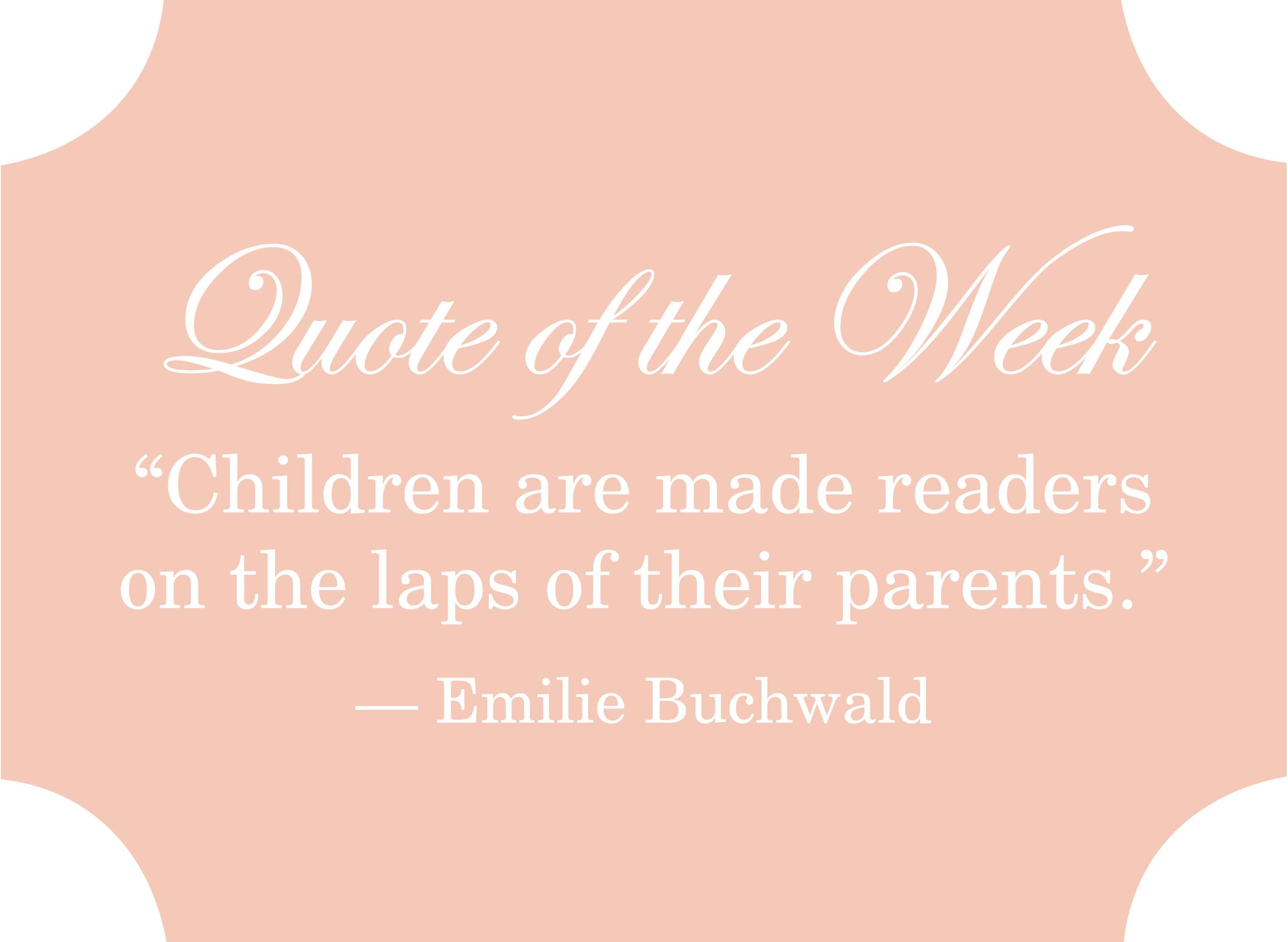
As the mother of two young boys, ages 4 and 7, I am keenly aware of the pressures that exist in our world, even for the smallest, most adorable members of society. Who is the smartest? Who is the fastest? Who is best at soccer, art, spelling or math? And the list goes on and on…
The fast paced nature of the modern world often does not offer many opportunities for our children to slow down, find self-acceptance and simply be. Childhood, while frequently thought of as a carefree period, is also a time of intense physical, emotional, social and intellectual growth and change. It can be challenging for even the most balanced of kids.
Yoga has been a blessing in my life for well over a decade. It has helped me through many of the most important and transformational moments, both the tremendously difficult and the incredibly beautiful ones. It has provided a safe space for me to reconnect with my body, calm my mind and find acceptance and peace when I have needed it the most. Sharing this tool with my children, one that I hope will be just the beginning of their exploration of the union of their bodies, minds and spirits, has been an enlightening experience for me, as a mother, yoga practitioner and teacher.
Yoga is a holistic approach to physical fitness and stress reduction. The beauty of yoga for children is that through a combination of playful poses, integrated with mindfulness affirmations and breathing techniques, it can provide a moment of joyful pause during the chaos of school, music lessons, sports practices and socializing with friends. If done thoughtfully, yoga will engage both a child’s body and mind, offering them multidisciplinary tools that cross over many learning styles. Through introducing children to their own inner resources in a lighthearted way, like self-soothing, centering, strength and flexibility, yoga can help them create a safe space to learn more about themselves, both physically and spiritually. Ultimately, the goal is to give them tools to help navigate their lives on a daily basis.
Now, all of this talk of mind-body connection and the benefits of yoga is great, but at this point you might be asking yourself, how can I make yoga accessible to my children, when many adults aren’t even comfortable with the idea of entering a yoga studio? Here are some helpful suggestions followed by a fun exercise in yoga and mindful affirmations:
Make sure that you choose a space where your child feels comfortable.
The beauty of yoga is that it is entirely portable. You do not have to practice in a yoga studio or a gym, you can do it almost anywhere! However, as many of us know, children can be lively and do better with some space to move around and express themselves. This can be in their bedrooms, your living room, the playground or just about anywhere you can find some room. If at all possible, it should also be in a place where they feel safe and is part of their normal routine.
Keep it simple.
I have found that when introducing new concepts to my children, it is helpful to not bog them down with too many abstract concepts that will likely go over their heads (do many of you speak Sanskrit out there? No, I didn’t think so). Stay within their age-appropriate realm of knowledge and comfort.
Tell it in a story and make it fun!
Make it easier for the little ones to follow along, by engaging them in a story that encourages affirmations and threads the poses together in a way that makes sense to them. Imaginative play, problem solving, cooperative activities and songs have always worked well for me. If you can weave the poses and affirmations into a tale that they are familiar with, even better!
To help get you started on the path to introducing your little ones to the benefits of a regular yoga and mindful affirmation practice, here is a sequence that my sons love. Depending on their age and experience, you can also pick fewer poses as you begin your exploration.
ANIMAL ADVENTURE YOGA
1. Calming/Setting Our intentions
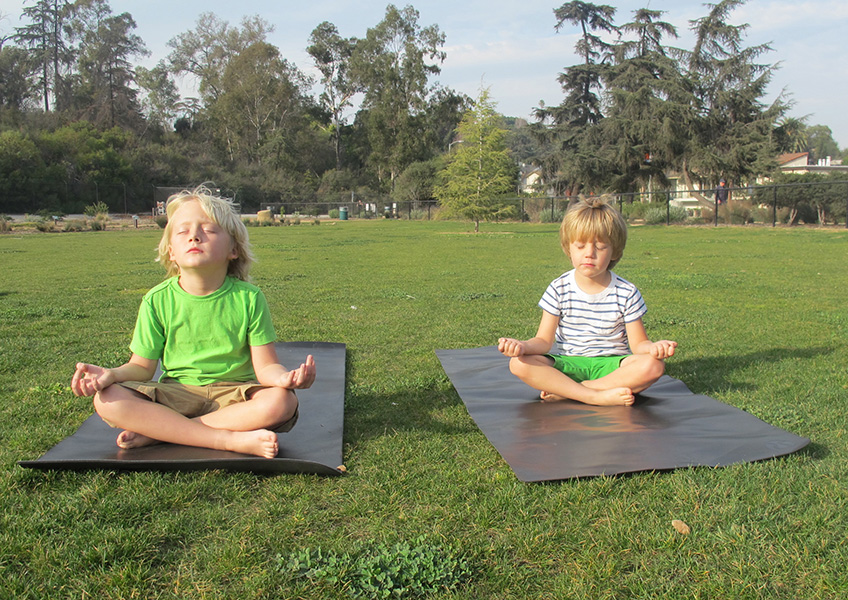 Have them start in a comfortable cross-legged position on the floor, with their eyes closed. Tell them to breathe through their noses as if they are smelling flowers. Ask them to notice how their breath moves in and out of their bodies. Have them place their hands on their bellies to feel how it is rising and falling with each breath. Ask them to repeat, “I am calm and peaceful” as they inhale and “it feels good” as they exhale. Do this for 5-10 breaths, while they calm down (hopefully!) and relax. This breathing exercise and affirmation is something that you can later encourage them to do at any point during their day.
Have them start in a comfortable cross-legged position on the floor, with their eyes closed. Tell them to breathe through their noses as if they are smelling flowers. Ask them to notice how their breath moves in and out of their bodies. Have them place their hands on their bellies to feel how it is rising and falling with each breath. Ask them to repeat, “I am calm and peaceful” as they inhale and “it feels good” as they exhale. Do this for 5-10 breaths, while they calm down (hopefully!) and relax. This breathing exercise and affirmation is something that you can later encourage them to do at any point during their day.
2. Cat pose
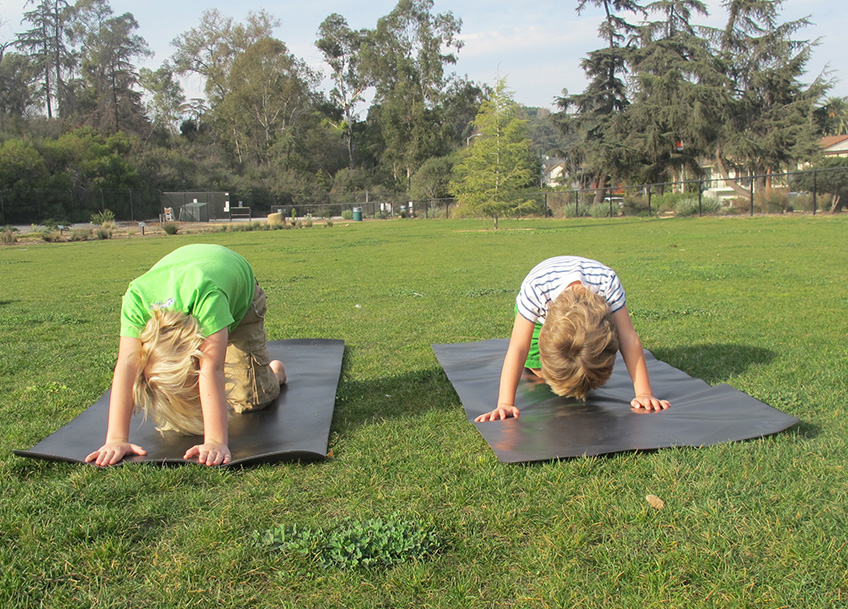 Our adventure starts with an animal many of us see around our neighborhoods. Come to all fours and press your paws into the floor. Tuck your chin into your chest and look towards your belly. Now meow like your favorite kitty!
Our adventure starts with an animal many of us see around our neighborhoods. Come to all fours and press your paws into the floor. Tuck your chin into your chest and look towards your belly. Now meow like your favorite kitty!
3.Cow pose
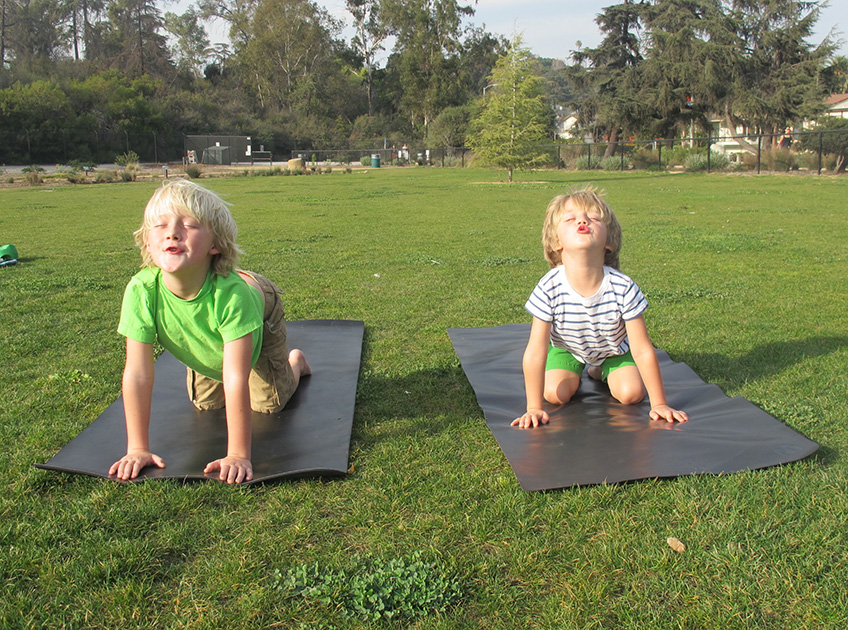 Our next stop is at the farm. Lower your bellies down towards the ground and lift your heads to the sky and moo!
Our next stop is at the farm. Lower your bellies down towards the ground and lift your heads to the sky and moo!
Repeat the cat/cow sequence 3-5 times.
4. Downward Dog
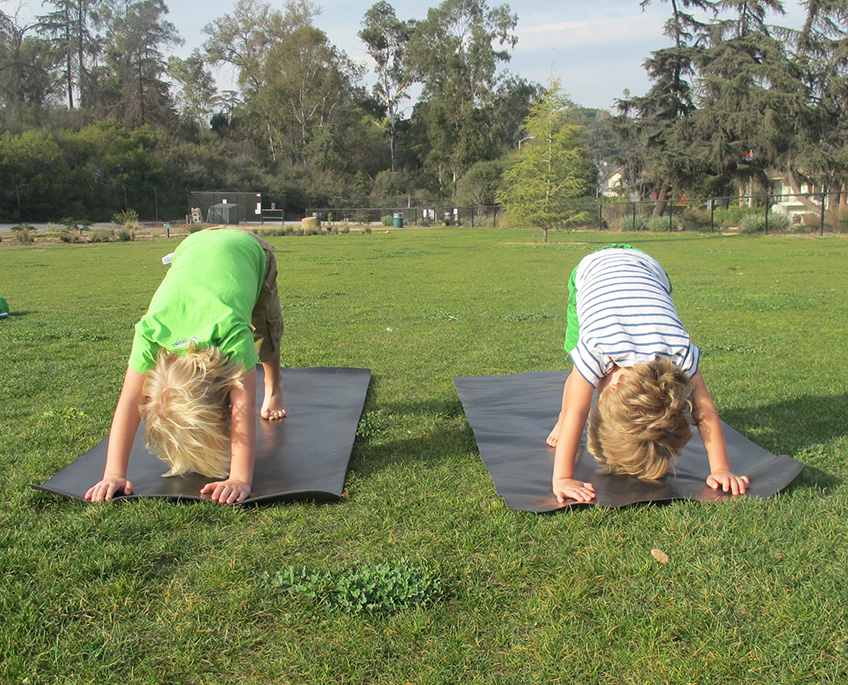 Here is one of our favorite animals, the doggy! Stretch your paws wide in front of you and lift your tail up to the sky while straightening your legs. Wag your tail from side to side and give a little bark!
Here is one of our favorite animals, the doggy! Stretch your paws wide in front of you and lift your tail up to the sky while straightening your legs. Wag your tail from side to side and give a little bark!
Hold for 3-5 breaths.
5. Snake Pose
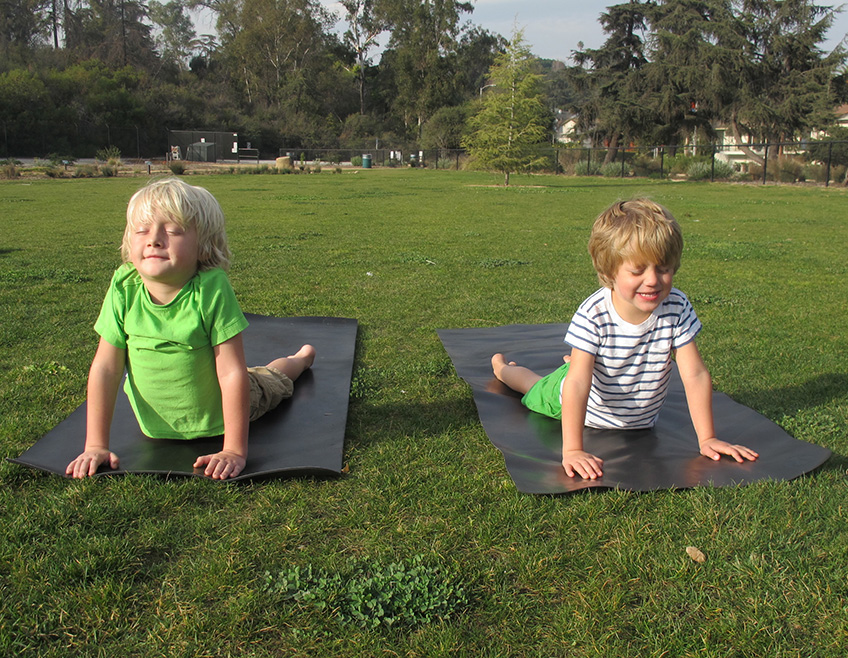 Lie down onto the ground and pretend to be a snake in the grass! Place your hands on the ground underneath your shoulders and lift your chest up with your strong arms and look towards the sky! Now hissssssss like a snake!
Lie down onto the ground and pretend to be a snake in the grass! Place your hands on the ground underneath your shoulders and lift your chest up with your strong arms and look towards the sky! Now hissssssss like a snake!
Hold for 3-5 hisses.
6. Butterfly Pose
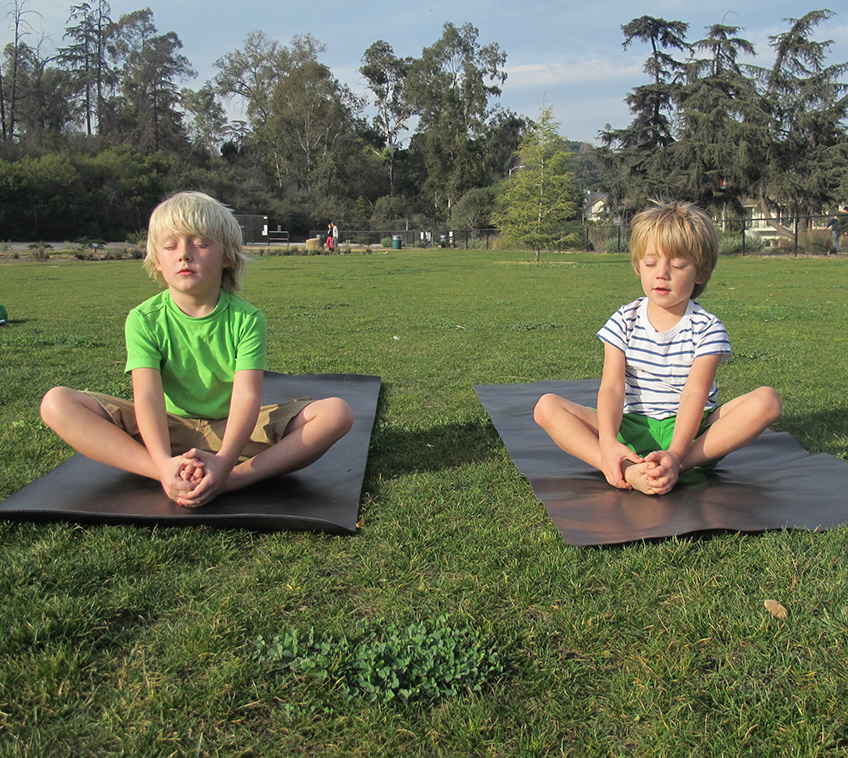 Come to a seated position and bend your knees out to the side and bring the bottom of your feet together. Sit up tall and place your hands around your toes. Breathe in while you bring your wings (knees) up and out while you bring your wings (knees) down. Repeat, “I am a beautiful butterfly, see me fly!” while you soar through the sky.
Come to a seated position and bend your knees out to the side and bring the bottom of your feet together. Sit up tall and place your hands around your toes. Breathe in while you bring your wings (knees) up and out while you bring your wings (knees) down. Repeat, “I am a beautiful butterfly, see me fly!” while you soar through the sky.
Repeat 3-5 times.
7. Lion’s Breath
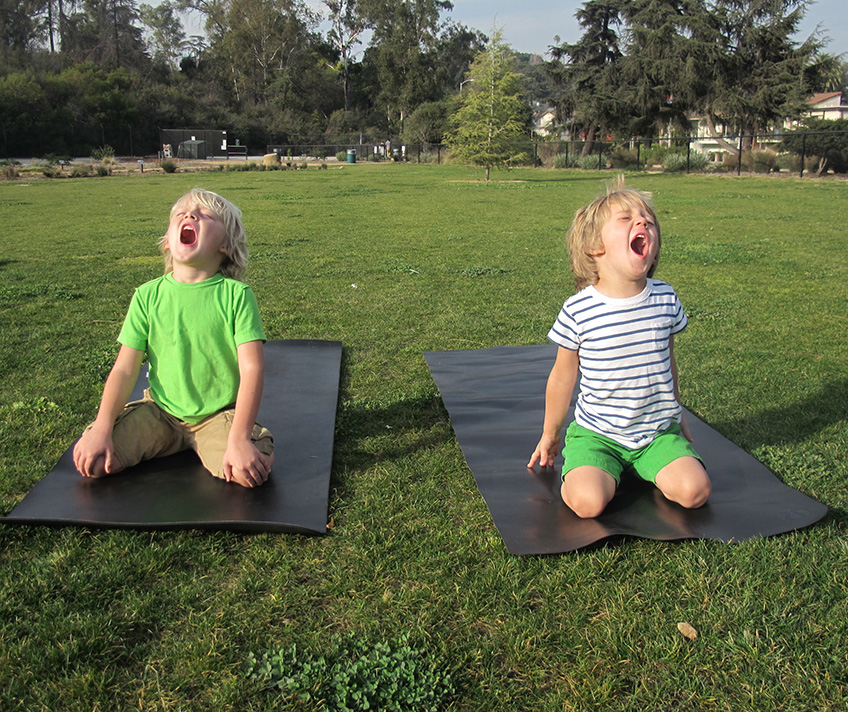 Come to kneeling and bring your toes together and your knees apart. Place your big paws on the tops of your thighs. Take a deep, deep breath and open your mouth wide and roar like the strong and powerful lion(ess) that you are.
Come to kneeling and bring your toes together and your knees apart. Place your big paws on the tops of your thighs. Take a deep, deep breath and open your mouth wide and roar like the strong and powerful lion(ess) that you are.
Repeat 3-5 times.
8. Child’s pose
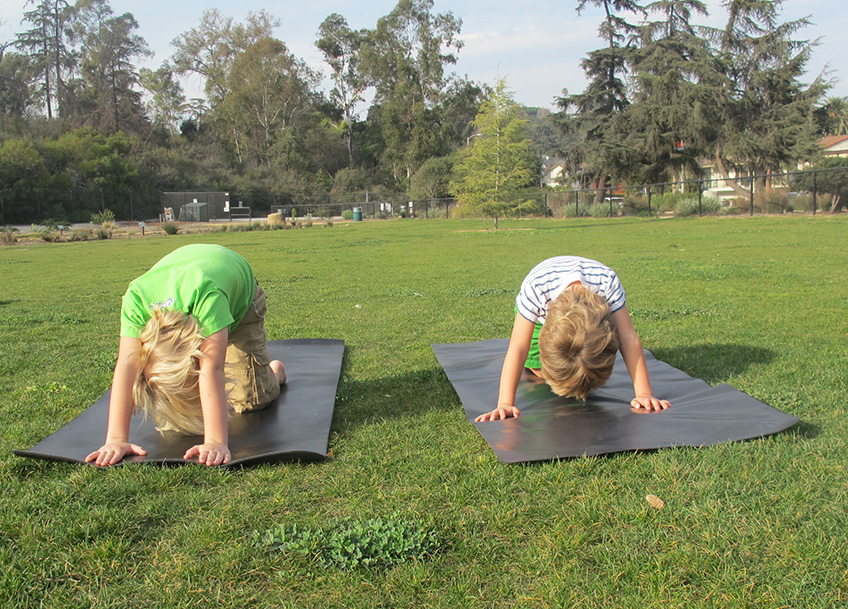 Lean forward and stretch your arms in front of you on the floor laying your body in between your legs. Close your eyes and relax into the floor. Start taking deep breaths through your mouth. When you inhale, think about breathing in all of the beauty of the animals we’ve been playing with and when you exhale, think about breathing out any bad feelings you have about your day. Do you feel your body slowing down as you breathe and relax? Does it feel good?
Lean forward and stretch your arms in front of you on the floor laying your body in between your legs. Close your eyes and relax into the floor. Start taking deep breaths through your mouth. When you inhale, think about breathing in all of the beauty of the animals we’ve been playing with and when you exhale, think about breathing out any bad feelings you have about your day. Do you feel your body slowing down as you breathe and relax? Does it feel good?
Hold for 5-10 breaths.
9. Closing
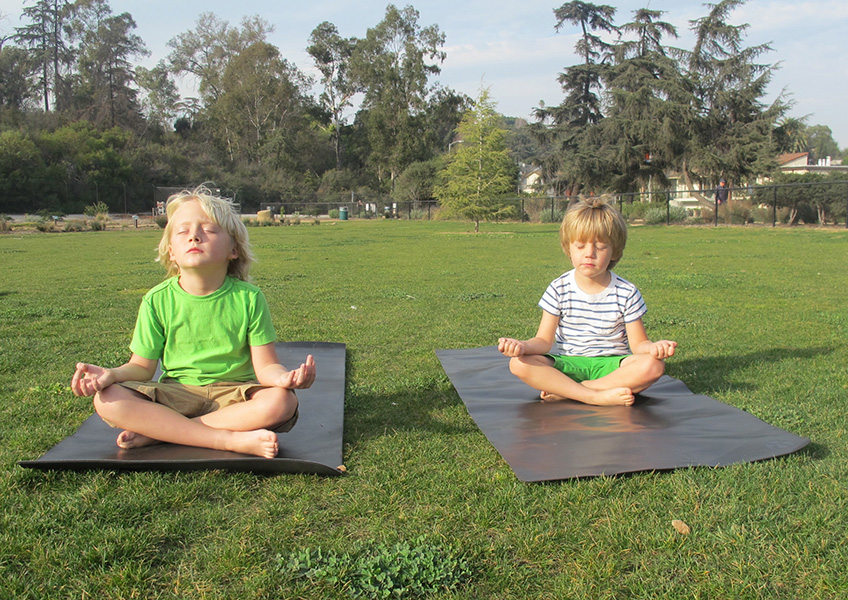 Come back to a comfortable cross-legged position with your hands in your lap. How do you feel after today’s animal yoga adventure? This is a great moment to reflect with the child on how he or she feels after their practice and learn what tools have been most effective for them.By introducing a child to yoga, you are opening them to the possibility of a happier, healthier and more balanced life. Take the time to explore with them and you will help them prepare their bodies, minds and spirits for whatever adventures may come their way.
Come back to a comfortable cross-legged position with your hands in your lap. How do you feel after today’s animal yoga adventure? This is a great moment to reflect with the child on how he or she feels after their practice and learn what tools have been most effective for them.By introducing a child to yoga, you are opening them to the possibility of a happier, healthier and more balanced life. Take the time to explore with them and you will help them prepare their bodies, minds and spirits for whatever adventures may come their way.
Namaste.
CREDIT: Svan Káradóttir
ABOUT THE AUTHOR: Svan Káradóttir was born in Iceland but moved with her family, at a young age, to Chicago, Il. She discovered yoga during her early twenties while studying for her MA in Art History at Tufts University in Boston, MA. After the birth of her first son, her interest in yoga grew, only to strengthen after the arrival of her second little man. Ever since, her yoga practice has served, amongst many other things, as a means of stress management, child-rearing, exploring her spirituality and physical conditioning. She received her 200 hour YTT certification from YogaMaze in Los Angeles in November 2013 and continues to learn more about the benefits of yoga and every day and shares them with everyone who will listen!
